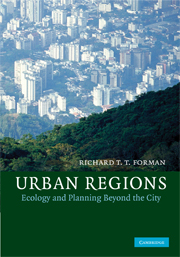Book contents
- Frontmatter
- Contents
- Foreword
- Foreword
- Preface
- Acknowledgments
- 1 Regions and land mosaics
- 2 Planning land
- 3 Economic dimensions and socio-cultural patterns
- 4 Natural systems and greenspaces
- 5 Thirty-eight urban regions
- 6 Nature, food, and water
- 7 Built systems, built areas, and whole regions
- 8 Urbanization models and the regions
- 9 Basic principles for molding land mosaics
- 10 The Barcelona Region's land mosaic
- 11 Gathering the pieces
- 12 Big pictures
- Appendices
- References
- Index
- Plate section
3 - Economic dimensions and socio-cultural patterns
Published online by Cambridge University Press: 04 August 2010
- Frontmatter
- Contents
- Foreword
- Foreword
- Preface
- Acknowledgments
- 1 Regions and land mosaics
- 2 Planning land
- 3 Economic dimensions and socio-cultural patterns
- 4 Natural systems and greenspaces
- 5 Thirty-eight urban regions
- 6 Nature, food, and water
- 7 Built systems, built areas, and whole regions
- 8 Urbanization models and the regions
- 9 Basic principles for molding land mosaics
- 10 The Barcelona Region's land mosaic
- 11 Gathering the pieces
- 12 Big pictures
- Appendices
- References
- Index
- Plate section
Summary
A friend suggested that a book on urban regions would focus overwhelmingly on economics. But that would unfairly place the ills, delights, and challenges of the world in one corner, whereas a range of human dimensions are central to understanding and solutions. Dividing the human condition into three overlapping categories – economics, social patterns, and culture – is convenient, though admittedly a simplification. Culture is used in its core sense of fundamental aesthetic, intellectual, and moral traditions. This glimpse of the three big subjects, economics in this section, and social patterns and culture in the final section, is obviously incomplete. Still, selected concepts, particularly linked with resource and environmental dimensions, provide useful foundations and insights.
Growth, regulatory, and ecological economics
Key economic systems for considering natural systems and their uses in urban regions are presented as follows: (1) growth economics and regulatory economics, which are familiar and in various combinations currently predominate in urban regions; and (2) ecological economics for resources and the environment, which is growing, because in many ways it complements and addresses the shortcomings of the familiar approaches.
A few background observations are helpful. First, most economic theories are essentially non-spatial. Places for people and habitats for species are basically ignored and unimportant in economic models. Yet since spatial arrangement is so important to understanding and policy in urban regions, linking economics and spatial pattern is included here.
- Type
- Chapter
- Information
- Urban RegionsEcology and Planning Beyond the City, pp. 51 - 79Publisher: Cambridge University PressPrint publication year: 2008



